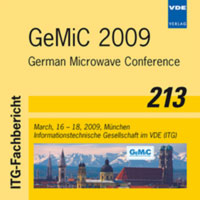First design investigations on a fully-electronic microwave imaging radiometer system
Conference: GeMiC 2009 - German Microwave Conference
03/16/2009 - 03/18/2009 at München, Germany
Proceedings: GeMiC 2009
Pages: 4Language: englishTyp: PDF
Personal VDE Members are entitled to a 10% discount on this title
Authors:
Schreiber, Eric; Peichl, Markus; Süss, Helmut (DLR (German Aerospace Center) Oberpfaffenhofen, Microwave and Radar Institute, 82230 Wessling, Germany)
Abstract:
Present applications of microwave remote sensing systems are spread out widely. One topic for using the frequency range1 - 300 GHz is the domain of security and reconnaissance. Examples are, the observation of sensitive areas or the performance of personal security checks in order to find hidden weapons or explosives, both being an important mean in our world of a growing international terrorism. The imaging capability of hidden objects is one of the main advantages of microwave remote sensing, because of the given penetration of electromagnetic waves through dielectric materials in this frequency domain. The physical effect used in passive microwave sensing relies on the thermal radiation of objects above a temperature of 0 K. The intensity of this radiation depends on the surface characteristics, the chemical and physical composition, and the temperature of the material. So it is possible to discriminate objects having different material characteristics like ceramic weapons or plastic explosives with respect to the human body. Considering the use of a people scanning system in airports, railway stations, or stadiums, it is important that passive microwave imaging devices have no exposure on the scanned object, like active devices do. Especially for highly frequent passed security gateways it is important to have a high through-put rate in order to minimize the queue time. Consequently fast imaging systems are necessary. In the following the conceptual idea of a fully-electronic microwave imaging radiometer system is introduced. The scanning mechanism for the two dimensions is divided into a frequency scan in one dimension and aperture synthesis in the other. The goal here is to design a low cost, fully electronic scanning system with a frame rate around one second at Ka band. This frequency domain is chosen as a well balanced compromise between the achievable spatial resolution and the penetration depth of the electromagnetic wave, which are conflictive requirements.


